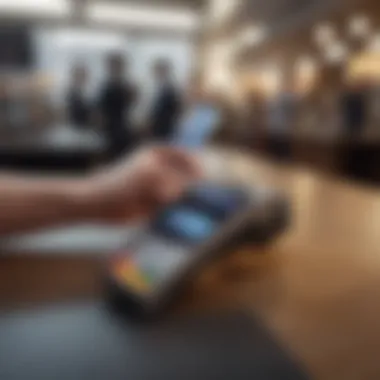Understanding Apple Pay Requests in Digital Payments


Intro
In a world where technology and finance are intertwined more than ever, understanding how digital payment systems operate is crucial. Apple Pay has emerged as a frontrunner among these systems, allowing users to make seamless transactions using just their devices. This article will peel back the layers of Apple Pay requests, providing readers with insights into its mechanics, security features, and impact on spending habits.
By exploring this landscape, we aim to equip readers—whether beginner investors or experienced financial enthusiasts—with the knowledge necessary to navigate this new era of digital payments, while also enhancing their financial literacy and strategic decision-making skills.
Investment Terminology
Understanding the jargon of any industry is a vital step toward comprehending its intricate mechanics. In the realm of digital payments and investments, certain terms and acronyms frequently arise. Getting acquainted with these can provide clarity when analyzing Apple Pay and similar systems.
Key Terms and Definitions
- Digital Wallet: A digital application that allows users to store, send, and receive money electronically. Apple Pay is a prime example of a digital wallet.
- Tokenization: A security process that replaces sensitive information with a unique identifier or token, minimizing the risk of fraud in transactions. Apple Pay employs tokenization to protect user data.
- Contactless Payment: A payment method that uses RFID technology to allow for secure transactions without needing physical contact. This is a core feature of Apple Pay, making purchases straightforward.
Common Acronyms in Finance
- NFC: Near Field Communication, a technology that enables devices to communicate when they’re close together—crucial for Apple Pay transactions.
- EMV: Europay, MasterCard, and Visa; a global standard for cards equipped with chips that improve security and interoperability.
- P2P: Peer-to-Peer, referring to technology that allows individuals to transfer money directly to each other without involved third parties, often used with digital wallets.
Expert Insights
Understanding insights from industry experts can guide individuals in making informed decisions. This section will outline fundamental investment strategies related to digital payments and provide advice from financial advisors to navigate potential pitfalls.
Investment Strategies Overview
Investing in digital payment systems like Apple Pay requires strategic thinking. Here are a few investment strategies to consider:
- Diversification: Don’t put all your eggs in one basket. Investing in a mix of fintech companies can reduce risks and increase potential returns.
- Market Research: Keeping abreast of the latest trends in digital payments can help investors identify technological advancements and emerging players in the space.
- Long-Term Focus: The digital payment landscape is evolving rapidly. A long-term investment perspective may yield higher returns as the field matures.
Tips from Financial Advisors
Industry experts often offer strategies on how best to approach this evolving market:
- Stay Informed: Regularly read reputable financial news sources and industry reports to stay updated on market shifts.
- Understand your Risk Profile: Every investor's situation is unique. Knowing how much risk you can tolerate will guide your investment choices effectively.
- Utilize Technology: Leverage apps and platforms that assist in tracking investments and analyzing market trends to make informed decisions efficiently.
"The key to mastering the digital payment revolution lies in grasping its fundamentals, knowing the market, and wisely managing your investment approach."
By distilling the essence of Apple Pay requests and their implications, we aim to enhance your understanding. Whether you're already involved in this space or considering a leap, knowledge is your strongest ally.
Preface to Apple Pay
In the rapidly evolving world of financial technology, Apple Pay has carved out a niche that is hard to overlook. The launch of this digital payment platform by Apple Inc. fundamentally altered how we approach transactions in our daily lives. It’s not just a payment method; it symbolizes a shift towards more efficient and secure payment processes. This article delves deep into the intricacies of Apple Pay requests and their broader implications in the expansive digital payment ecosystem.
Definition and Overview
So, what exactly is Apple Pay? Put simply, it's a mobile payment and digital wallet service that allows users to make secure transactions using their Apple devices. This can range from iPhones to iPads and even the Apple Watch. The beauty of Apple Pay lies in its ability to integrate seamlessly with various platforms and services, making it incredibly user-friendly.
• Mobile Wallet: Users can store their credit and debit cards in the Wallet app. • Contactless Payment: A tap or glance is all it takes at stores, speeding up the check-out process. • In-app Purchases: You can make purchases with just a few taps, eliminating the hassle of entering card details.
Apple Pay also emphasizes security. Unlike traditional methods, it employs unique encryption technologies that help protect sensitive data. Each transaction generates a one-time security code, which adds a layer of protection not typically found with physical cards. In essence, Apple Pay isn't merely a convenience; it is an example of how technology can enhance user safety in financial transactions.
Historical Context of Mobile Payments
To comprehend the significance of Apple Pay, one must first unriddle the history of mobile payments. The concept of paying via mobile phones first emerged in the early 2000s. At that time, services were rudimentary, often requiring clunky user interfaces and complex setups. The landscape has gradually transformed, thanks to the advent of smartphones and advancements in technology.
- Early Days: The first mobile payments were often linked to SMS systems, allowing users to charge purchases to their phone bills.
- NFC Introduction: Near Field Communication (NFC) technology became a game changer, allowing transactions to become faster and more secure.
- Rise of Digital Wallets: Companies like Google and Samsung began launching their own digital wallets, creating a competitive ecosystem where convenience and security became paramount.
With the launch of Apple Pay in 2014, the stage was set for a revolution. This service not only advanced the mobile payment landscape but also influenced consumer habits towards contactless payments, setting the standard for how we engage with financial transactions today.
"The launch of Apple Pay was more than just a new feature; it was a key shift in consumer expectations surrounding payment digitalization."
In summation, understanding Apple Pay's role in mobile payments provides insight into the future of finance. As we explore the various components of Apple Pay requests in this article, recognizing this context will help frame the conversation around its mechanics and broader implications.
The Mechanics of Apple Pay Requests
Understanding the mechanics behind Apple Pay requests is crucial in today’s fast-paced digital landscape. As platforms facilitating transactions constantly evolve, knowing how these systemswork helps users make better financial decisions. In this section, we’ll explore how Apple Pay operates and how users can initiate payment requests effectively, shedding light on elements that contribute to its growing popularity.


How Apple Pay Works
Apple Pay employs a well-structured technology that allows users to make payments seamlessly. The service utilizes Near Field Communication (NFC), which enables secure data transfer from the user’s device to the payment terminal without physical contact.
When you add a card to Apple Pay, the actual card number isn’t stored on your device. Instead, it generates a unique Device Account Number for each card, minimizing the risk of exposure. Each transaction then involves a dynamic security code, making it ever so difficult for fraudsters to exploit.
Moreover, Apple Pay integrates with various payment networks like Visa and Mastercard, enhancing its applicability across numerous services. The entire transaction flow is swift, allowing consumers to pay with a simple tap of their device.
Key Components of Apple Pay Operation
- Device Account Number: A unique identifier for each card, enhancing security.
- Dynamic Security Code: A one-time code included in each transaction, preventing unauthorized uses.
- NFC Technology: Facilitates contactless payments, reducing the time taken during checkouts.
This seamless interaction between hardware and software illustrates the thought Apple has put into user experience.
Initiating a Payment Request
Initiating a payment request using Apple Pay is as straightforward as it gets. Users need to engage with their device’s wallet feature to begin the process.
Usually, this involves tapping the relevant app, be it a grocery store’s checkout or an online retailer's page. Once the user selects Apple Pay as their payment method, they might be prompted to authenticate using Face ID, Touch ID, or a passcode. This step is essential as it ensures that the individual making the payment is authorized to do so.
Steps to Initiate Payment
- Open the wallet app or relevant application on your device.
- Select the card to be used for the transaction.
- Confirm the payment amount.
- Authorize the transaction using your preferred authentication method.
- Hold the device near the payment terminal to complete the transaction.
This process simplifies transactions and puts control back into the hands of consumers. It's interesting to note that many users find the speed and ease of Apple Pay empowering, particularly during busy shopping seasons or in fast-paced environments.
"With the push of a button, I can buy my morning coffee without fumbling for cash or cards. Apple Pay makes my life so much easier!" - A satisfied user
User Experience and Accessibility
When it comes to Apple Pay, the user experience and accessibility aspects can sometimes be overlooked, yet they play a vital role in how well the service is received by different types of users. A well-optimized user experience attracts a broad audience, ensuring that both tech-savvy individuals and those unfamiliar with digital payments can navigate the system with ease. Accessibility is crucial not just from a usability standpoint, but it also reflects on Apple's commitment to inclusivity, catering to various segments of society.
Interface Design Considerations
For any digital payment platform, the interface design serves as the gateway for user interactions. Apple Pay is built with a clean, intuitive interface that aims to minimize friction during transactions.
- Simplicity: The layout is straightforward, which helps in reducing the learning curve for new users. Even if you're not tech-savvy, you can grasp how to make transactions without needing a manual.
- Visual Hierarchy: Key information is prominently displayed. This allows users to quickly find what they need without getting lost in a sea of options, whether it’s making a payment or checking transaction history.
- Feedback Mechanism: Notifications, confirmations, and alerts guide users throughout the transaction process, which reduces anxiety that can arise from managing financial operations.
- Aesthetic Appeal: A clean design is not just about function; it also has a psychological impact. Users feel more at ease and confident when the interface looks modern and visually appealing.
These design elements are no small potatoes when it comes to retention; they significantly enhance overall user satisfaction and encourage repeated use.
Inclusivity in Digital Payments
Digital payment systems have a reputation for sometimes excluding various demographics, but Apple Pay aims to break that mold. The service is designed with inclusivity in mind, targeting a wide array of consumers, irrespective of their background or abilities.
- Support for Various Languages: Apple Pay respects its global audience by offering multi-language support, ensuring that non-native English speakers feel welcomed and can perform transactions without encountering language barriers.
- Accessibility Features: Apple has integrated features that support users with disabilities. VoiceOver, for instance, enables visually impaired users to engage with the interface easily.
- Compatibility Across Platforms: Apple Pay is not limited to high-end devices; it also supports older models and a variety of platforms, making it accessible to individuals who may not have the latest tech.
- User Education: Apple provides resources and tips aimed at educating users about the functionalities of Apple Pay. This empowers users to become more comfortable with the technology.
Ultimately, a commitment to inclusivity enhances customer loyalty and expands Apple Pay's reach in the competitive digital payment landscape.
"A user-friendly interface combined with accessibility can significantly transform the landscape of digital payments, allowing everyone to participate in the financial ecosystem."
The design and accessibility features of Apple Pay are not just about making transactions; they shape the entire experience, fostering a sense of community and trust.
Security Features of Apple Pay
In a world increasingly reliant on digital transactions, security plays a pivotal role, especially in systems like Apple Pay. Understanding the security features embedded in Apple Pay is crucial for both consumers and businesses. These features are not just technical add-ons; they represent a fundamental commitment to safeguarding sensitive financial information. As digital payments surge, users and financial entities must grasp these elements, ensuring trust in this electronic marketplace.
Encryption and Data Protection
When users tap into Apple Pay, that's more than just a convenient payment method; it's a vault of encryption that keeps their data safe. At the heart of this system lies a robust encryption protocol that masks user information from potential threats. Traditional card numbers are replaced with a unique Device Account Number, which is securely stored in the device’s Secure Element. This means that, during a transaction, the retailer never even sees your credit card details.
"Apple Pay doesn’t share your actual card number; it sends a one-time payment token, minimizing exposure to fraud."
The encryption technology used ensures that all communication between your device and the payment terminal is scrambled and unreadable to eavesdroppers. It's akin to speaking in a coded language that only your device and the payment terminal can understand. Additionally, biometric authentication, using Face ID or Touch ID, adds another layer of security. This ensures that only authorized users can initiate payments, minimizing the risk of unauthorized transactions.
Fraud Prevention Strategies
While encryption is crucial, Apple Pay takes a multi-faceted approach to fraud prevention. One cannot simply rely on a single layer of security; Apple recognizes this and implements numerous strategies.


- Real-time Transaction Monitoring: Apple Pay incorporates systems that analyze transactions in real-time, flagging anything suspicious for further review. This can include unusual spending habits or transactions from new devices.
- Tokenization: As mentioned before, tokenization replaces sensitive information with unique identifiers, meaning that even if hackers intercept data, they receive worthless tokens instead of actual card numbers.
- User Alerts: Apple Pay sends notifications for transactions, allowing users to stay informed and report unauthorized activity immediately. This timely alert system acts as an early warning for potential fraud attempts.
These strategies promote a secure environment, encouraging greater adoption of contactless payments. However, no system is foolproof. Users should remain vigilant and regularly monitor their accounts.
The synergy of encryption and layered fraud prevention techniques illustrates Apple's commitment to enhancing user confidence while navigating the waters of digital payments.
Challenges and Limitations
As we navigate the evolving landscape of digital payments, it becomes clear that the journey with Apple Pay isn’t all smooth sailing. While its innovative features have changed the way consumers and businesses approach transactions, several challenges and limitations are embedded within the system. Understanding these hurdles is crucial, whether one is a casual user, a financial enthusiast, or a seasoned investor.
Technical Issues in Payment Processing
Every modern payment system dances a delicate jig with technology. In the case of Apple Pay, technical issues can arise that may disrupt user experience and hinder the trust consumers place in digital payments. These problems can range from minor glitches during transactions to significant system outages that cripple payment processes.
For instance, some users report intermittent failures in transaction processing when they attempt to pay using their Apple devices in certain retail environments. Imagine standing in line, ready to make a purchase, only to encounter an error prompting you to swap payment methods. Such snags can lead to frustration and can impact the perception of reliability that Apple Pay strives to maintain. Moreover, compatibility with different merchant systems can be hit-or-miss, raising concerns about the universality of the platform.
It's not just the users who feel the pressure; merchants too face challenges. They may incur transaction fees or have to invest in upgrading point-of-sale systems to ensure compatibility with Apple Pay's infrastructure. This can be a considerable barrier, especially for small businesses operating within tight budgets. Therefore, these technical issues aren't merely irritations; they have far-reaching implications across the board.
Market Limitations and Adoption Rates
The market landscape for digital payment solutions is as competitive as a dog-eat-dog world. Apple Pay, while effective, isn't the only player in the game. Despite Apple's vast user base, adoption rates of Apple Pay vary significantly across regions and demographics. In some areas, users have fully embraced contactless payments, while in others, traditional methods like cash and card still reign supreme.
Here’s where the rubber meets the road: many consumers remain cautious about switching to digital payment methods. This reluctance can stem from various factors, such as a lack of familiarity, concerns about cybersecurity, or even simple inertia. Statistics suggest that demographics heavily influence adoption rates; younger individuals may be more inclined to jump on board compared to older generations who might prefer what they know.
Moreover, regulatory hurdles also come into play. In different countries, the legal framework surrounding digital payments might not be as accommodating, imposing limits on usage or requiring additional compliance steps. This, combined with the varied levels of technological infrastructure available worldwide, presents a mixed bag that could either boost or stifle the growth of Apple Pay in certain markets.
In summary, while Apple Pay holds great promise as a digital payment solution, significant challenges remain. Technical pitfalls can cause friction for users and merchants, while market factors shape adoption rates unevenly. Understanding these hurdles is key for consumers looking to navigate the evolving payment terrain and for stakeholders eager to capitalize on this burgeoning sector.
Impact on Consumer Behavior
The emergence of Apple Pay has dramatically shifted how consumers engage with their finances and make purchases. As digital payment methods gain traction, understanding their impact on consumer behavior becomes paramount. Apple Pay represents a convergence of technology and financial services, bringing along specific benefits that affect spending habits and overall purchasing experiences.
Shift towards Contactless Payments
As more individuals prioritize convenience and safety, the trend towards contactless payments has gained substantial momentum. Apple Pay facilitates this shift with its quick and effortless method of completing transactions. Users can simply tap their phones at a compatible terminal, cutting down on time spent in line or fumbling for cash. This ease of use resonates particularly with younger consumers who are more inclined to adopt new technology.
"Once you've tried Apple Pay, going back feels like stepping into the Stone Age."
There’s more to this phenomenon than just convenience. Contactless payments are becoming synonymous with hygiene, especially in a world that has grown increasingly cautious about surface contact. The ongoing global situation has made consumers more wary of handing over cash or credit cards. Instead, using their phones or smartwatches feels safer. In this way, Apple Pay not only enhances user experience but also reflects shifting societal norms around money handling.
Moreover, businesses are recognizing this shift. Many are rapidly adapting to this new landscape by upgrading their payment systems, thereby encouraging a more seamless customer interaction. As customers, we often gravitate towards solutions that make our lives easier, and this inclination helps in solidifying Apple Pay’s position in the marketplace.
Influence on Spending Habits
The way Apple Pay is designed holds the potential to influence not just how we pay, but also how much we spend. With a single tap, purchasing becomes almost imperceptibly simple. Consumers report spending more when using digital wallets compared to traditional methods. This might be explained by the psychological disconnect that occurs when we use cards or phones instead of cash. When we use cash, there is a tangible sense of loss, while swiping or tapping often doesn’t carry the same emotional weight.
Additionally, integrated budgeting features within the Apple ecosystem, such as tracking expenses, provide users with deeper insights into their spending patterns. This might seem counterintuitive—after all, if you can track expenses, shouldn’t you feel more accountable? For many, the instant nature of digital payments may lead to impulse buying, as the momentary thrill of a purchase overshadows the aftershock of the bill.
Nonetheless, the role of Apple Pay isn’t only about spending. Users, especially seasoned investors and financial enthusiasts, find value in effectively monitoring their transactions. People can adjust spending habits through the data provided by these budgeting tools, making them more intentional about future purchases.
In essence, Apple Pay operates as both a convenience and a behavioral influence. As it encourages more digital transactions, it can lead consumers into a complex relationship with their spending habits—one that balances ease of use and impulse alongside the need for financial awareness.
Integration with Personal Finance
In an age where digital payment methods are becoming standard, the integration of services like Apple Pay into personal finance management cannot be overstated. This synergy between payment solutions and budgeting practices equips users to not only make purchases but also fosters a greater understanding of their spending habits. This relationship serves two main purposes: tracking expenses and enhancing financial literacy.
By utilizing Apple Pay, users can seamlessly link their transactions to budgeting tools. This reduces friction in managing finances and promotes a broader awareness of financial health. Essentially, when a payment is made via Apple Pay, it can be automatically recorded in budgeting apps. This automatic recording alleviates the tedious task of manually inputting data, which means tracking your spending becomes almost effortless.
Apple Pay and Budgeting Tools
The integration of Apple Pay with budgeting tools creates a streamlined approach to managing finances. Apps such as Mint, YNAB (You Need A Budget), and Personal Capital can sync with Apple Pay transactions. For instance, if you’re out grabbing a coffee and you use Apple Pay, that expense can instantly update your budget in YNAB without lifting a finger. This immediate feedback loop allows users to see how even small purchases chip away at their monthly allowance.
- Real-Time Expense Tracking:
- Customized Budgeting Strategies:
- Visual Representation of Spending Patterns:
- Expense categories update instantaneously as transactions occur.
- Users can monitor their daily spending without any delays, enabling better decision-making.
- Users can set spending limits and track how they compare in real-time against their goals.
- This flexibility empowers individuals by giving them the tools to create financial strategies that work for them.


- Graphs and charts available in many budgeting apps make it clearer to see where money is flowing.
- This can shed light on unexpected spending areas and promotes mindful consumption.
Tracking Transactions Effectively
When it comes to personal finance, knowing where your money goes is key. Apple Pay aids in making this process smooth, but effective transaction tracking goes beyond mere integration. It encompasses diligence and regular review of financial data. Here are a few considerations for tracking transactions efficiently:
- Periodic Reviews:
Schedule weekly or monthly reviews to analyze your spending through Apple Pay reports. Recapping your transactions helps in recognizing any recurring expenses that may have been overlooked. - Alerts and Notifications:
Take advantage of alerts to keep an eye on spending. Many budgeting tools linked to Apple Pay offer notifications for exceeding set limits, ensuring that you’re always on top of your financial game. - Categorization of Expenses:
- Categorizing can also help to root out unnecessary expenditures.
- This feature can often be automated within budgeting applications, allowing users to prioritize which areas to cut back on.
"By making personal finance tools easily accessible, Apple Pay encourages a culture of budgeting and financial awareness that benefits users in the long run."
Through the integration of Apple Pay with personal finance, users can gain better control of their financial future, aligning spending with their financial goals. This not only modulates how they interact with money but ultimately fosters a disciplined approach to managing their finances.
The Role of Financial Institutions
The influence of financial institutions in the realm of digital payments, particularly with systems like Apple Pay, cannot be overstated. They serve as the lifeblood of these transactions, bridging the gap between consumers and payment options. Their participation essentiallly shapes the experience, security, and overall efficacy of Apple Pay requests.
With a robust framework set up by banks and credit unions, users are not just looking at plain conveniences—there are dozens of nuances that affect everything from transaction speed to the likelihood of approval.
Partnerships with Banks and Credit Unions
Financial institutions form the backbone of any payment ecosystem. The partnership between Apple Pay and banks or credit unions is crucial for providing seamless service. These entities facilitate the necessary infrastructure that enables Apple Pay to function flawlessly.
- Access to Networks: Banks provide Apple Pay access to their networks, ensuring that users can transact without a hitch. When a consumer taps their phone to pay, the transaction goes through the bank’s network, allowing for almost instantaneous processing.
- Trust Factor: The affiliation with recognized banks and credit unions elevates the trust factor in a digital age. Users tend to gravitate towards systems that involve traditional financial institutions because it provides that sense of security. A strong connection signals stability, especially for those who might be hesitant to adopt more futuristic payment options.
- Innovations in Payment Solutions: Collaborating with tech-savvy startups, banks are increasingly integrating their services with platforms like Apple Pay. This joint venture is poised to teach both sectors valuable lessons and to innovate services that could reshape the digital payment landscape.
Fees and Revenue Models
Understanding the financial implications of using Apple Pay requires a detailed look at fees and revenue models tied to financial institutions.
- Transaction Fees: Often, banks impose a small fee for each transaction processed through Apple Pay. This fee, while usually minimal, can add up quickly for businesses with a high volume of transactions. It's worth noting that this cost may not always be passed on to the consumer directly, but in many cases, it contributes to the pricing structure of goods or services.
- Revenue Sharing Models: Banks may partner with Apple and agree on a revenue-sharing model, where both parties benefit from the transaction fees generated through Apple Pay. Such models incentivize banks to promote the platform, thus improving accessibility for everyday users.
- Incentives For Users: To encourage the adoption of Apple Pay, many banks are rolling out rewards programs. Customers earn points or cash back on transactions, encouraging them to use Apple Pay more frequently.
"Financial institutions aren't just participants; they are key players working behind the scenes to enhance and secure the user experience in digital payments."
Future Trends in Digital Payments
The realm of digital payments is on the brink of a transformation, driven by rapid technological advancements and changing consumer behaviors. As mobile wallets like Apple Pay continue to evolve, understanding future trends in this landscape becomes increasingly important. These developments not only promise smoother transactions but also redefine security, accessibility, and overall user experience. With the population becoming more tech-savvy, recognizing these shifts can aid investors and financial enthusiasts in making educated choices regarding digital payment solutions.
Emerging Technologies on the Horizon
The integration of emerging technologies is set to revolutionize digital payments in a monumental way. Here are several key trends worth examining:
- Blockchain Adoption: The use of blockchain technology stands out as a significant evolution. Transactions on a blockchain can be more secure, efficient, and transparent, presenting a clear advantage over traditional payment methods. The decentralized nature of these networks reduces reliance on intermediaries, lowering costs for consumers and businesses alike.
- Artificial Intelligence: AI is already making inroads into fraud detection. With machine learning algorithms, payment systems can analyze transactions in real-time, flagging anything unusual. This not only helps in preventing fraud but also instills confidence for users.
- IoT (Internet of Things): As more devices connect online, they can facilitate transactions without traditional input means. Think smart refrigerators that can order groceries or cars that pay for fuel without user interaction. This evolution represents convenience, yet it raises essential discussions around security and privacy.
- 5G Technology: With the rollout of 5G, digital payments can become faster and more reliable. A robust connection can significantly decrease loading times for payment processing, minimizing wait times for customers at point-of-sale systems.
This can streamline experiences not just for the consumer but also for business owners, enhancing efficiency across the board.
Changing Landscape of Digital Wallets
As digital wallets gain traction, the landscape is changing rapidly. Three noteworthy aspects emerge:
- User-Centric Features: Wallets are evolving to offer tailored experiences. Features such as customized financial insights, budget monitoring tools, and loyalty programs are becoming standard. These elements engage users and keep them coming back.
- Cross-Platform Functionality: A growing trend is the ability to interface across various platforms seamlessly. Users expect to perform transactions from multiple devices—whether on their smartphones, smartwatches, or other wearables. This flexibility is crucial in today's fast-paced environment.
- Global Accessibility: As digital wallets become commonplace, there exists a larger emphasis on making these services accessible in emerging markets. From helping unbanked populations to facilitating cross-border transactions easily, the push for inclusivity can tap into previously underbanked demographics.
"The future of digital payment isn’t just about convenience; it’s about crafting an ecosystem that empowers users and fosters trust in the technology they utilize."
Overall, the future trends in digital payments reflect a initiative towards more personalized and secure experiences that could influence spending habits and financial decisions. For both beginners and seasoned investors, staying abreast of these developments is crucial. As innovation intertwines with everyday transactions, understanding how to navigate this landscape may provide not just practical advantages, but also insights into the next wave of financial technology.
Ending
Wrapping up this exploration of Apple Pay requests, it is crucial to analyze how these digital payment mechanisms affect not just individual users but the financial landscape as a whole. The significance of Apple Pay in today’s market cannot be understated, as it facilitates a smoother transaction process, enhances security measures surrounding digital payments, and adjusts to evolving consumer expectations.
Recap of Key Points
Throughout the article, we have uncovered several vital elements concerning Apple Pay:
- User Experience: The interface is user-friendly, making it accessible for folks with various tech skills.
- Security Features: Advanced encryption and fraud prevention strategies safeguard user data.
- Impact on Consumer Behavior: A shift toward contactless payments has been noticed, shaped significantly by Apple Pay's convenience.
- Relationship with Financial Institutions: Strong collaborations between Apple and various banks enhance the acceptability and reliability of the payment system.
- Future Trends: The space of digital payments is constantly changing, with emerging technologies gradually taking center stage.
"Understanding the nuances of payment systems like Apple Pay equips consumers with the tools to navigate the increasingly complex financial world."
Encouraging Informed Decision-Making
In a market flooded with options, making informed decisions stands paramount. Users — whether casual purchasers or seasoned investors — should consider how Apple Pay aligns with their financial goals. Recognizing the benefits of utilizing such digital wallets can lead to more efficient spending and budgeting practices.
Furthermore, an awareness of security features can enhance peace of mind. As users gain confidence in these digital payment tools, they can better capitalize on the conveniences they provide, thus optimizing their overall financial strategy. Remember, knowledge is power, especially in a world where technology and finance interlace intricately.















